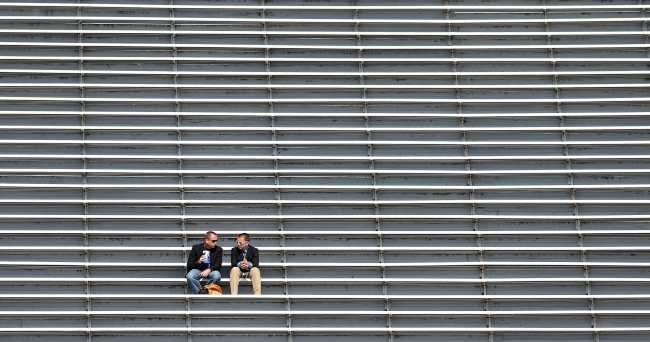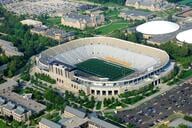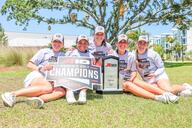You have /5 articles left.
Sign up for a free account or log in.

Getty Images
Game day. For many college alumni, the phrase alone is enough to conjure autumnal memories of watching football while surrounded by cheering student sections, marching bands, and brisk fall air.
But an increasing number of students, researchers say, now see the experience a little differently. For them, attending a football game more likely means sitting outdoors for hours in chilly weather, with little or no access to cell phone reception and alcohol. Once the tailgate party has ended, why not just cheer on the home team from a bar down the street? There are probably some cheap game-day specials, and there may even be free wifi.
Student attendance at major college football games is declining across the country. By how much varies greatly at each institution, but a recent Wall Street Journal analysis of turnstile data at 50 public colleges with top football programs found that average student attendance is down more than 7 percent since 2009.
In 2013, the University of Georgia's designated student section was nearly 40 percent empty. The University of California at Berkeley has sold about 1,000 fewer student season tickets this season than last year -- a season that already saw a decline from the previous one. Since 2009, student attendance at the University of Florida has dropped 22 percent. Three-fourths of the University of Kansas' student tickets went unused last season.
The students who do still attend games tend to arrive later and leave earlier, said Richard Southall, director of the College Sports Research Institute, which can be an embarrassing headache for athletic programs.
"Fundamentally, students are part of the show and that's something that folks don't always recognize," Southall said. "If you watch a college sports telecast, where do the cameras go for in-crowd shots? The cameras are in the student section. If that section is not there, it's like having a movie without enough extras to walk in the background of the shots. I always joke to my students, 'You understand you're paying to be extras. You're just there for the show, so everyone else can keep consuming it.' "
As universities may sometimes build ticket prices into student fees or offer unsold tickets to alumni and other fans, overall sales have not dropped dramatically, Southall said. Football revenues at large programs still often hover between $50 and $80 million a year, according to the U.S. Department of Education, and even top $100 million at institutions like the University of Texas. But that could begin to change over the next decade or two.
Today's uninterested students, athletic directors worry, could easily become tomorrow's uninterested alumni.
"Current students are not that important [to ticket sales], per se," Dan Rascher, a sports management professor at the University of San Francisco, said. "But you're trying to turn those current students into former students who are still fans decades later. You want students, when they become alumni, to have that attachment and come back for the games, and that's what's concerning athletic departments."
A possible link between athletics -- particularly success in athletics -- and alumni giving has been debated for decades. Older studies are split about the issue, but more recent research argues that there is a connection, especially between football and donations to athletic programs rather than a university's general fund.
The culprits for the downward trend in student attendance are not difficult to identify, said Mark Nagel, a professor of sports and entertainment management at the University of South Carolina.
Tickets are getting more expensive, nonconference games are less evenly matched, and -- thanks to lucrative and far-reaching broadcast contracts -- it's never been easier to watch games from the comfort of just about anywhere else. Students can often watch their college's team play not just on television, but also on their computers, smart phones, and tablets.
"Students just have so many other choices now," Nagel said. "TVs are getting inexpensive. The quality is getting better and better. Students are thinking, 'Do I really want to go? Is it too hot? Too cold? Would I rather go watch the game somewhere more comfortable? Is it going to be a boring game?' "
The more difficult question to answer, Southall said, is what can colleges and universities do to slow or halt the decline.
"Students are showing that they're consumers like anyone else," he said. "As college sports have become more and more commercialized, they're having to compete with that home experience like the NFL and everybody else."
Some institutions are hoping that part of the solution lies in replicating aspects of watching the games on television. Last year, the Big Ten Conference announced that its colleges could now show an unlimited number of replays at any speed on stadium videoboards, mirroring the multiple, slow-motion replays commonly featured in game broadcasts.
Previously, stadiums were allowed to show just one replay at only 75 percent of the actual speed. “Our goal on game day is to blend the best parts of an in-stadium experience with the best parts of an at-home experience,” Jim Delany, the Big Ten’s commissioner, said at the time.
More commonly, universities are trying to attract student fans by adding more amenities to stadiums and transforming the game day experience into something that can’t be found at a bar or in someone’s living room.
“We’re seeing more and more incentives,” Nagel said. “And we’re also seeing a trend toward creating a larger entertainment experience. The game on the field is still the centerpiece, but there’s more fireworks, more giveaways, more promotions. That’s the wave of the present.”
More than half of Division I FBS institutions plan on spending more than $10 million on facility investments over the next year, according to a recent survey conducted by Ohio University’s Center for Sports Administration and stadium designer AECOM. The top three priorities for that spending -- enhancing food and beverage options, premium seating, and connectivity -- all focus on the experience of fans, rather than the players.
Earlier this year, the University of Nebraska at Lincoln approved a $12.3 million project for installing a better sound system and wireless internet in its stadium. The University of California at Berkeley is now offering freshman season tickets, usually available for a $99 fee, for free. And 21 college-owned stadiums now sell alcohol, according to a survey conducted by the Associated Press. That's double the number from five years ago.
"Even though it's important to look at the macro issue, everything about how to solve this is really local," Nagel said. "Numbers could be down at some stadiums, but certain schools could be up. It really is a situation where every school have their own micro issues that need to be dealt with.
"But they share the same concern: If students don't have that affinity for their team as young people, when they're 35 years old with a lot of expendable income, are they going to make the decisions their parents have as fans?"




